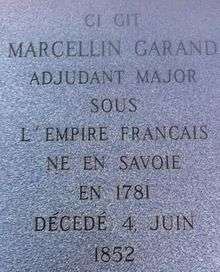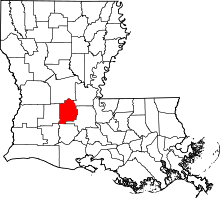Ville Platte, Louisiana
| Ville Platte, Louisiana | |
| City | |
| Name origin: Ville Platte, French ('Ville' being the French word for 'city' and 'platte' meaning 'flat') | |
| Country | United States |
|---|---|
| State | Louisiana |
| Parish | Evangeline |
| Elevation | 72 ft (21.9 m) |
| Coordinates | 30°41′21″N 92°16′39″W / 30.68917°N 92.27750°WCoordinates: 30°41′21″N 92°16′39″W / 30.68917°N 92.27750°W |
| Area | 4.0 sq mi (10.4 km2) |
| - land | 4.0 sq mi (10 km2) |
| - water | 0.0 sq mi (0 km2), 0% |
| Population | 7,430 (2010) |
| Density | 1,849.3/sq mi (714.0/km2) |
| Mayor | Jennifer Vidrine (D) |
| Timezone | CST (UTC-6) |
| - summer (DST) | CDT (UTC-5) |
| ZIP code | 70586 |
| Area code | 337 |
|
Location of Ville Platte in Louisiana | |
 Location of Louisiana in the United States | |
| Website: www | |
Ville Platte is a city in the U.S. state of Louisiana and the parish seat of Evangeline Parish.[1] The population was 7,430 at the 2010 census,[2] down from 8,145 at the 2000 census. The city's name is French roughly translating to "flat city", in reference to its relatively flat topography in contrast to the more hilly terrain north of the area.
History

The area around Ville Platte appears to have been first settled during the last half of the eighteenth century, when Louisiana was under Spanish rule. The earliest record of settlement in the immediate area of Ville Platte was in the 1780s.
Popular legend states the founder of Ville Platte was Marcellin Garand, an adjutant major in the Army of the French Empire during the reign of Napoleon. In 1824, Garand obtained one of the first two lots that were platted in what is now Ville Platte, with the second being obtained by a Doctor Robert Windex. Those lots were obtained from the estate of William O'Donegan. This appears to be the actual beginning of, or the founding of, the present town of Ville Platte.
The first post office in Ville Platte was established in 1842 with Marcellin Garand as postmaster from 1842 to 1848. [3]
Geography
Ville Platte is located in eastern Evangeline Parish at 30°41′21″N 92°16′39″W / 30.68917°N 92.27750°W (30.689140, -92.277534).[4]
According to the United States Census Bureau, Ville Platte has a total area of 4.0 square miles (10.4 km2), of which 0.25 acres (0.001 km2), or 0.01%, is water.[2]
U.S. Route 167 passes through the city as Main Street (eastbound) and Lasalle Street (westbound). The highway leads southeast 17 miles (27 km) to Opelousas and north 52 miles (84 km) to Alexandria. Louisiana Highway 10 passes through the city in tandem with US 167 but leads northwest 28 miles (45 km) to Oakdale.
Chicot State Park, Louisiana's largest state park, is located 8 miles (13 km) north of Ville Platte. The park covers 6,400 acres (26 km2) of rolling hills and water and has large numbers of deer, raccoon, and other wildlife.
Demographics
| Historical population | |||
|---|---|---|---|
| Census | Pop. | %± | |
| 1870 | 135 | — | |
| 1880 | 149 | 10.4% | |
| 1900 | 163 | — | |
| 1910 | 603 | 269.9% | |
| 1920 | 1,364 | 126.2% | |
| 1930 | 1,722 | 26.2% | |
| 1940 | 3,721 | 116.1% | |
| 1950 | 6,633 | 78.3% | |
| 1960 | 7,512 | 13.3% | |
| 1970 | 9,692 | 29.0% | |
| 1980 | 9,201 | −5.1% | |
| 1990 | 9,037 | −1.8% | |
| 2000 | 8,145 | −9.9% | |
| 2010 | 7,430 | −8.8% | |
| Est. 2015 | 7,264 | [5] | −2.2% |
As of the census[7] of 2000, there were 8,145 people, 3,169 households, and 2,047 families residing in the city. The population density was 2,665.4 people per square mile (1,027.7/km²). There were 3,513 housing units at an average density of 1,149.6 per square mile (443.3/km²). The racial makeup of the city was 40.53% White, 58.67% African American, 0.21% Native American, 0.07% Asian, 0.11% from other races, and 0.41% from two or more races. Hispanic or Latino of any race were 1.23% of the population.
There were 3,169 households out of which 32.6% had children under the age of 18 living with them, 35.9% were married couples living together, 24.5% had a female householder with no husband present, and 35.4% were non-families. 33.0% of all households were made up of individuals and 16.3% had someone living alone who was 65 years of age or older. The average household size was 2.48 and the average family size was 3.17.
In the city the population was spread out with 30.9% under the age of 18, 9.1% from 18 to 24, 23.7% from 25 to 44, 19.3% from 45 to 64, and 17.0% who were 65 years of age or older. The median age was 34 years. For every 100 females there were 85.5 males. For every 100 females age 18 and over, there were 79.1 males.
The median income for a household in the city was $12,917, and the median income for a family was $18,056. Males had a median income of $29,798 versus $16,563 for females. The per capita income for the city was $9,672. About 43.5% of families and 50.9% of the population were below the poverty line, including 68.9% of those under age 18 and 32.5% of those age 65 or over.
Education
Public schools in Evangeline Parish are operated by the Evangeline Parish School Board. Three campuses are located in Ville Platte - James Stephens Montessori School (Grades PK-4), Ville Platte Elementary School (Grades PK-4), and Ville Platte High School (Grades 5-12).
There is also two private schools. Sacred Heart of Jesus Catholic School is a Roman Catholic school, serving grades PK-12. Christian Heritage Academy is a Christian school, serving grades PK-12.
The famous St. Landry Parish Sheriff Cat Doucet was educated in Ville Platte.[8]
Culture
Ville Platte is located at the heart of Louisiana's Cajun country. The town is famous for its smoked meat and swamp pop music, and bills itself as "Smoked Meat Capital of the World". Ville Platte has been officially designated by the Louisiana Legislature at the "Swamp Pop Capital of the World," recognizing the town's "long, rich history of fostering the development of swamp pop music."
Ville Platte has significant Creole and Cajun cultural associations (cuisine, music, language etc.). It lies at the northern point of the "French Triangle" with a significant francophone population residing in the city as well as the parish. It is one of the birthplaces of the Afro-creole zydeco music that has become one of the signatures of Louisiana culture throughout the world, as well as the Choctaw-Métis tradition of "viande boucanee" or smoked meat.[9]
Ville Platte hosts two large festivals each year. The Louisiana Cotton festival, run in conjunction with the Le Tournoi, and the Festival de la Viande Bouccanee (Smoked Meat Festival) are held in Ville Platte annually. Ville Platte and the surrounding areas participate in the traditional Mardi Gras held in Mamou. [10] [11] [12]
Radio host Jim Soileau, the "Voice of KVPI" throughout most of the past 50 years, is semi-retired but still host the French News as well as co-host "La Tasse de Café" (“The Cup of Coffee”) on Monday and Wednesday mornings. He has one of the most recognized voices in Acadiana and hosted "This is Mamou Cajun radio" from location at Fred's Lounge for many years. [13] [14]
Government
Former U.S. Representative T. Ashton Thompson of Louisiana's 7th congressional district, since disbanded, was born in Ville Platte in 1916. He died in office in 1965 as a result of injuries sustained in an automobile accident in Gastonia, North Carolina. His death paved the way for Edwin Washington Edwards to assume the seat.
Bernard LeBas, a Ville Platte pharmacist, has represented Evangeline and St. Landry parishes in the Louisiana House of Representatives since 2008.[15]
Walter L. Lee served as the Evangeline Parish Clerk of Court for 56 years, from 1956-2012.
City officials:
- Mayor: Jennifer Vidrine, 2011-present
- Former mayor: Bill Jeanmard, 2007-2011
Members of the City Council:
- C. J. Dardeau
- Mike Perron
- Reverend Freddie Jack
- Donald Sam
- Jerry Joseph
- Bryant Riggs
- City Clerk: Shountilez Williams
- Deputy Clerk: Cliff Fontenot
- Chief of Police: Neil Lartigue
Points of interest
- Chicot State Park
- Alexis LaTour House
- Cazo Refinery
- Chief Romeo J. Hargrove City Park
- Crooked Creek Recreation Area
- Swamp Pop Museum
- Jin Records
- Flat Town Music Co
References
- ↑ "Find a County". National Association of Counties. Retrieved 2011-06-07.
- 1 2 "Geographic Identifiers: 2010 Demographic Profile Data (G001): Ville Platte city, Louisiana". American Factfinder. U.S. Census Bureau. Retrieved February 10, 2016.
- ↑ "History of Ville Platte". Ville Platte Chamber of Commerce. Retrieved 2016-09-29.
- ↑ "US Gazetteer files: 2010, 2000, and 1990". United States Census Bureau. 2011-02-12. Retrieved 2011-04-23.
- ↑ "Annual Estimates of the Resident Population for Incorporated Places: April 1, 2010 to July 1, 2015". Retrieved July 2, 2016.
- ↑ "Census of Population and Housing". Census.gov. Retrieved June 4, 2015.
- ↑ "American FactFinder". United States Census Bureau. Retrieved 2008-01-31.
- ↑ "Doucet, Daly Joseph "Cat"". lahistory.org. Retrieved December 15, 2010.
- ↑ "Louisiana's French Creole Culinary & Linguistic Traditions: Facts vs. Fiction Before and Since Cajunization," by John laFleur & Brian Costello w/ Dr. Ina Fandrich, 2013
- ↑ "Louisiana Cotton Festival". Louisiana Cotton Festial. Louisiana Cotton Festival, Inc. Retrieved 1 October 2016.
- ↑ "Louisiana Tournoi". Louisiana Tournoi. Retrieved 1 October 2016.
- ↑ "LA Smoked Meat Festival". LA Smoked Meat Festival. LA Smoked Meat Festival Non-profit Organization. Retrieved 1 October 2016.
- ↑ Fausset, Richard (14 February 2015). "In Louisiana, Desire for a French Renaissance". The New York Times. Retrieved 1 October 2016.
- ↑ Porzucki, Nina (4 March 2015). "This Louisiana radio station likes their news 'en Franglais'". Public Radio International. Retrieved 1 October 2016.
- ↑ "H. Bernard LeBas". house.louisiana.gov. Retrieved May 7, 2015.
